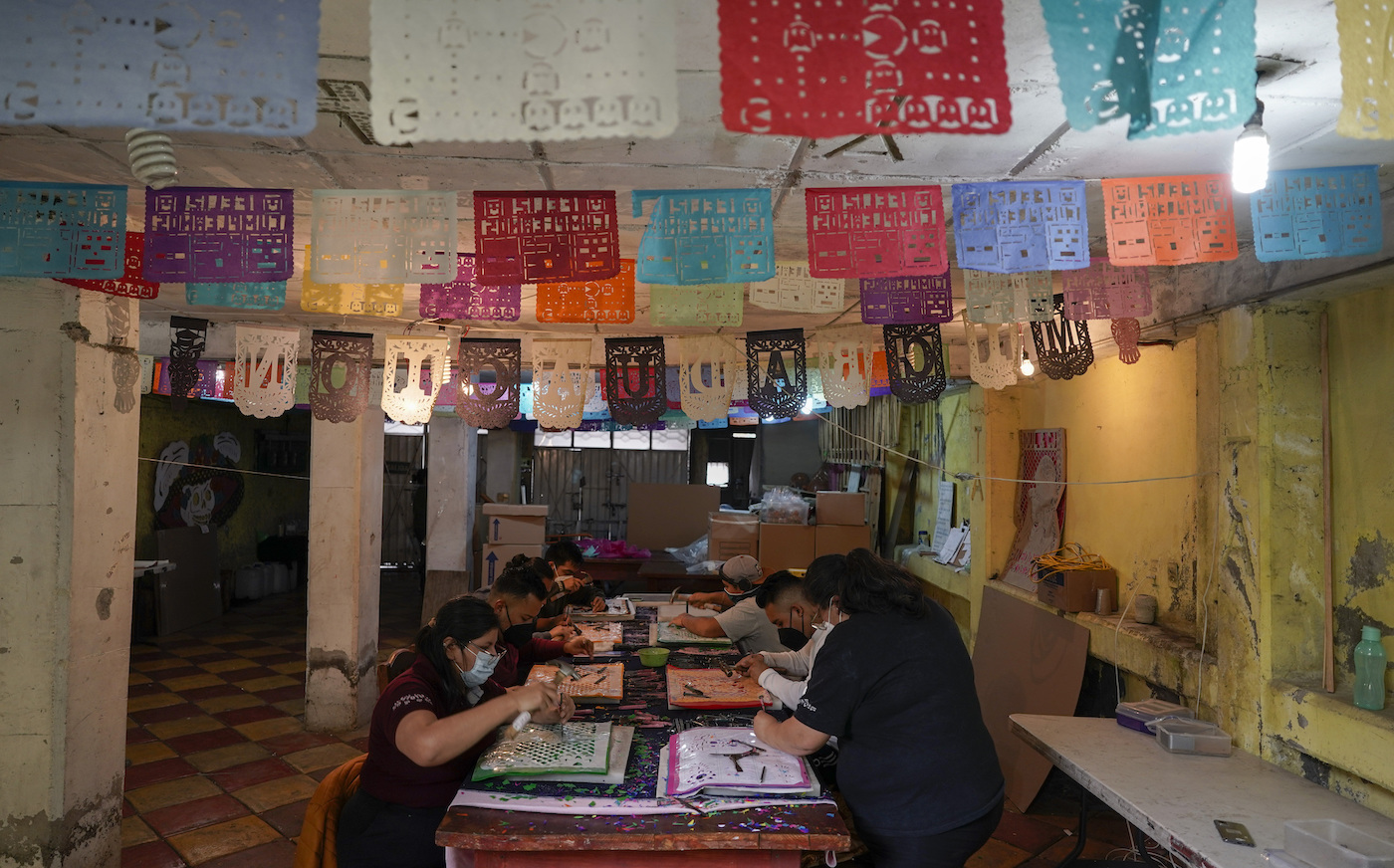「死者の日」の祭壇を飾るのに長く使われてきた切り絵の伝統的な製法をメキシコの職人は苦労しつつ守り通している。
切り絵作りでは二代目となるユリディア・トーレス・アルファロ氏(49)は、首都メキシコシティ南部のソチミルコにある実家の工房で、いまや主流となった大量生産技術に抗いつつ、変わらず独自のステンシル(文字や絵柄などをくり抜いたシート)を作っている。

AP Photo/Eduardo Verdugo
「パペルピカド・ソチミルコ」という名前の工房で、幼いころより厚い束となった薄葉紙に恐怖を感じるほど鋭いノミを打ち込んできた。
耐久性のあるプラスチックシートやレーザーカッター、既成のステンシルが使われているなかにあって、200年前からメキシコの職人がしていたように、ひとつひとつの工程を手作業で行っている。

AP Photo/Eduardo Verdugo
1988年、教師をしていた父親が市役所の飾りつけで大量の注文を請け負った。こうした依頼では通常、祝祭日向けに骸骨、髑髏、死に神、カトリーナ(骸骨の貴婦人)を求められることが多い。
「この仕事をはじめたのは34年前で、当時は工房の規模も小さく、その仕事の手伝いをしていた」とアルファロ氏は当時の様子を振り返る。
専門家によると、1800年代を起源とし薄葉紙を使った飾り切り絵「パペルピカド」は、スペイン人がメキシコにやって来る前から存在していたとされる。イチジクの皮で作った紙に儀式用の人物を描く伝統があった。メキシコの職人が輸入薄葉紙を使うようになったのは安価で薄い素材だったからで、鋭利な道具を使い、細心の注意を払ってさまざまな技を用いて加工すれば一度に何十枚も切ることができた。
だが最も重要なのはステンシルである。表面をみると切り取られる部分が指定してあり、切り取った後には、建物や通りに飾られるような、複雑な模様のふわふわした網状の紙が残る。メキシコの多くの家庭では、亡くなった親類を偲び、死者に思いを寄せるのに使われる「死者の日」用の祭壇にパペルピカドを飾りつける。

AP Photo/Eduardo Verdugo
死者の日は10月31日にはじまり、この日は事故死した人を追悼する。11月1日は幼くして亡くなった人、11月2日はそれ以外の故人を偲ぶ。
伝統的に、紙(パペル)が鮮やかで色とりどりなのには理由がある。オレンジは追悼、青は溺死者、黄は老衰による死者、緑は若くして亡くなった者の象徴とされる。
多くのメキシコ人は、死者の日以外にも屋根などにパペルピカドを飾りつけるが、日差しや降雨にも強いプラスチック製のものが好まれる。
また、大量生産されたステンシルを使おうとする者もいる。それなら同じ模様が施されたシートが何万という単位で生成される。
「大量に作るとなると大変な労力がかかるため、パペルピカドを作るためのステンシルが出回るようになった」と、いまでも独自の模様でステンシルを手作りしているアルファロ氏は話している。「私たちは伝統的なやり方でこの作業を続けていきたい。数は少なくてもその人に合ったものができるし、日々新しい模様を作ることができるから」だという。

AP Photo/Eduardo Verdugo
また、死者の日とほぼ時期が重なるアメリカの祝日「ハロウィン」とも競合している。仮装、映画、パーティー、お菓子など、ハロウィンは華やかで市場性も高いことから、メキシコでも人気を集めている。
「ここ最近、ハロウィン系のものがやや多くなってきた」とした上で、「私たちの方は、メキシコでもっと長い歴史がある。メキシコ的なものをパペルピカドに取り入れることも仕事の一部だ。ハロウィン的なものは、顧客から注文があったときに限られる」と話している。
その他、21世紀のテクノロジーを駆使した試みとしてコンピューターが生成した模様やレーザーカッターなどを利用する人もいる。
だがアルファロ氏によると、切ることばかりに神経を集中していると、最も重要な部分ともいうべき、残された紙が持つ繊細な網目を見逃すことになる。
「レーザー機が人気のようだが、実際に確認したところ費用は(手作業と)変わらなかった。機械は穴単位で切断していくものの、それほど多くの量を切断できなかった。既製のステンシルやレーザー機には欠点もある。パペルピカドは、切ることができるものとできないものから成り立っている。それがパペルピカドの不思議な魅力だ」と話している。

AP Photo/Eduardo Verdugo
—
By FERNANDA PESCE Associated Press
XOCHIMILCO, Mexico (AP)
Mexican artisans are struggling to preserve the traditional manufacture of paper cut-out decorations long used in altars for the Day of the Dead.
Defying increasingly popular mass-production techniques, second-generation paper cutter Yuridia Torres Alfaro, 49, still makes her own stencils at her family’s workshop in Xochimilco, on the rural southern edge of Mexico City.
As she has since she was a child, Torres Alfaro punched stunningly sharp chisels into thick piles of tissue paper at her business, ‘Papel Picado Xochimilco.’
While others use longer-lasting plastic sheets, laser cutters or pre-made stencils, Torres Alfaro does each step by hand, as Mexican specialists have been doing for 200 years.
In 1988, her father, a retired schoolteacher, got a big order for sheets — which usually depict festive skeletons, skulls, grim reapers or Catrinas — to decorate city government offices.
“The business was born 34 years ago, we were very little then, and we started helping in getting the work done,” Torres Alfaro recalled.
Begun in the 1800s, experts say ‘papel picado’ using tissue paper is probably a continuation of a far older pre-Hispanic tradition of painting ceremonial figures on paper made of fig-bark sheets. Mexican artisans adopted imported tissue paper because it was cheap and thin enough so that, with sharp tools, extreme care and a lot of skill, dozens of sheets can be cut at the same time.
But the most important part is the stencil: its design designates the parts to be cut out, leaving an intricate, airy web of paper that is sometimes strung from building or across streets. More commonly, it is hung above Day of the Dead altars that Mexican families use to commemorate — and commune with — deceased relatives.
The holiday begins Oct. 31, remembering those who died in accidents; it continues Nov. 1 to mark those died in childhood, and then those who died as adults on Nov. 2.
Traditionally, the bright colors of the paper had different meanings: Orange signified mourning, blue was for those who drowned, yellow was for the elderly deceased and green for those who died young.
But many Mexicans — who also use the decorations at other times of year, stringing them at roof-height along streets — now prefer to buy plastic, which lasts longer in the sun and the rain.
Still other producers have tried to use mass-produced stencils, which means that tens of thousands of sheets might bear exactly the same design.
“Stencils began to appear for making papel picado, because it is a lot of work if you have to supply a lot of people,” said Torres Alfaro, who still hand-cuts her own stencils with original designs.
“We wanted to keep doing it the traditional way, because it allows us to make small, personalized lots, and keep creating a new design every day,” she says.
Another rival was the U.S. holiday Halloween, which roughly coincides with Day of the Dead, Because it is flashier and more marketable — costumes, movies, parties and candy — it has gained popularity in Mexico.
“For some time now, there has been a bit more Halloween,” said Torres Alfaro. “We do more traditional Mexican things. That is part of the work, to put Mexican things in papel picado. If we do Halloween things, it’s only on order” from customers.
Still others have tried to use 21st-century technology, employing computer-generated designs and laser cutters.
But Torres Alfaro says that concentrating so much on the cutting leaves out the most important part: the delicate webs of paper left behind.
“There are some laser machines that are gaining popularity, but we have checked them and the costs are the same, the machines still cut hole-by-hole and they can’t cut that many sheets,” she said.
“The (ready-made) stencils and the laser machine have their downsides,” she said. “Papel picado is based on what can be cut, and what can’t, and that is the magic of papel picado.”
By FERNANDA PESCE Associated Press
XOCHIMILCO, Mexico (AP)



